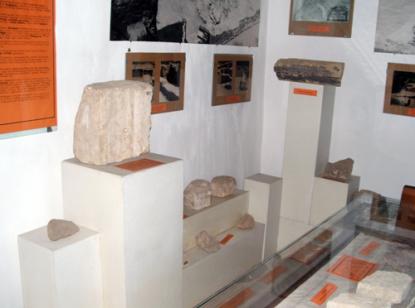2025. November 15. Saturday
Village Museum - Szegvár
|
|
Address: 6635, Szegvár Hunyadi János utca 31.
Phone number: (63) 313-352, (20) 567-9298
E-mail: tancosnora@freemail.hu
Opening hours: 01.04-31.10.: Wed-Fri 9-13, Sat-Sun: on prior notice
|
Museum tickets, service costs:
|
Ticket for adults
|
400 HUF
|
|
|
Ticket for students
|
200 HUF
|
|
|
Group ticket for students
(from over 10 people)
|
100 HUF
|
|
|
Ticket for pensioners
|
200 HUF
|
|
|
Ticket for families
(2 adults + 3 children)
|
600 HUF
|
/ family
|
|
Program ticket for students
|
200 HUF
|
|
|
Guide
|
1500 HUF
|
|
|
Photography
|
1000 HUF
|
|
|
Video
|
1000 HUF
|
In the last room we can see the rocks and iron pieces of the catles of Szeg.

In the beginning of the 16th century the castellum built by János Dóczy served as a defendable fort of the vicinity. The village was named after the name of this fort. In the 17-18th century the word 'vár' (castle) was added to the name, thus forming the current name of the settlement: Szegvár.
The village was burnt doen by the the peasants of the nearby Dónáttornya. The Turkish ranks destroyed it in 1552, but the people returned some 8 to 10 years later and lived in peace with the Turks for 80 years.
The fundaments of the stronghold were excavated under the supervision of archaeologist-manager Dr. Gabriella Vörös. However, finances were not enough to complete the work. We hope that the excavation will be complete some day and that our visitors can look at the fundaments of the former castle.
Presently the rocks of the castle are worth looking at from the St. John bridge. The bridge was named after St. John of Nepomuk. A statue of St. John was erected by Máté Forray in 1795.

In the beginning of the 16th century the castellum built by János Dóczy served as a defendable fort of the vicinity. The village was named after the name of this fort. In the 17-18th century the word 'vár' (castle) was added to the name, thus forming the current name of the settlement: Szegvár.
The village was burnt doen by the the peasants of the nearby Dónáttornya. The Turkish ranks destroyed it in 1552, but the people returned some 8 to 10 years later and lived in peace with the Turks for 80 years.
The fundaments of the stronghold were excavated under the supervision of archaeologist-manager Dr. Gabriella Vörös. However, finances were not enough to complete the work. We hope that the excavation will be complete some day and that our visitors can look at the fundaments of the former castle.
Presently the rocks of the castle are worth looking at from the St. John bridge. The bridge was named after St. John of Nepomuk. A statue of St. John was erected by Máté Forray in 1795.
